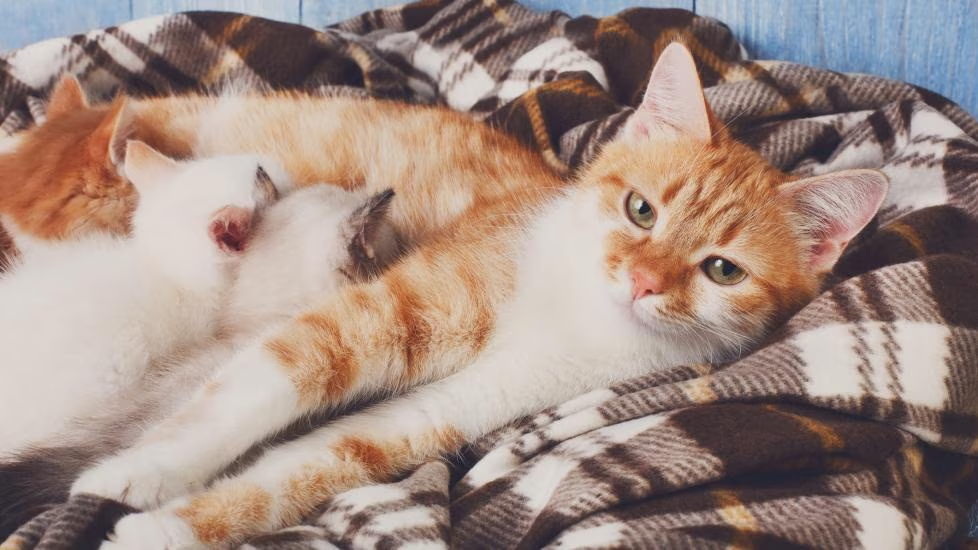Pregnancy in cats, also known as “queening,” is an exciting and crucial phase in a cat’s life. Whether you’re a first-time cat owner or an experienced pet parent, understanding the signs, stages, and the necessary care during your cat’s pregnancy can make all the difference for her health and the health of her kittens. In this article, we’ll dive into everything you need to know about cat pregnancy, from recognizing the early signs to providing the best care for your expectant feline.
Signs Your Cat is Pregnant
Recognizing the early signs of pregnancy in cats can be challenging, especially if it’s her first pregnancy. However, several indicators can help you determine if your cat is expecting.
1. Changes in Behavior
One of the first noticeable signs of pregnancy in cats is a shift in behavior. Early in pregnancy, a cat might become more affectionate, seeking out attention and wanting to be near her owner. Alternatively, some cats may become more reserved and avoid interaction. If your cat suddenly starts behaving differently, it could be a sign that she’s pregnant.
2. Changes in Appetite
Pregnant cats may have a noticeable increase in appetite, especially in the second half of their pregnancy. This is due to the nutritional demands of the growing kittens. On the other hand, some cats might experience nausea or slight loss of appetite during the early stages, similar to human morning sickness.
3. Changes in the Nipples
A clear and visible sign of pregnancy in cats is changes to their nipples. Around 15-18 days after conception, a pregnant cat’s nipples will become more prominent, larger, and may even change color, turning a darker pink or red. This is because the body is preparing to nurse the kittens.
4. Weight Gain and Abdominal Changes
As the pregnancy progresses, you will start to notice physical changes in your cat’s body. The most noticeable one is weight gain. A pregnant cat’s abdomen will gradually enlarge as the kittens grow inside. In the later stages, you may even feel the kittens moving around in her belly. However, it’s important to avoid pressing too hard on her belly as it may cause discomfort.
Stages of Cat Pregnancy
Understanding the different stages of your cat’s pregnancy helps you know what to expect as she progresses through this exciting and often delicate period.
1. The First Week to Three Weeks: Early Pregnancy
In the early stages, your cat may not exhibit many visible signs. However, the fertilized eggs implant into the uterus, and hormonal changes begin. The most noticeable signs may include changes in her nipples and some early changes in behavior.
2. The Middle of Pregnancy (4th to 6th Week)
This is when your cat’s belly will start to show signs of expansion. Her appetite will also increase as she begins to need more nutrients to support her growing kittens. Her mood may fluctuate, so it’s important to keep an eye on her and make sure she’s comfortable.
3. The Final Weeks (7th to 9th Week)
In the final stage of pregnancy, your cat will begin to prepare for the arrival of her kittens. Her belly will grow significantly, and you might notice some nesting behaviors. At this point, she may seek out quiet, comfortable spots in the home to give birth. This is when it’s important to start preparing for the actual birth.
Caring for a Pregnant Cat
Proper care during pregnancy is vital to ensure both the health of the mother and her kittens. Here are some essential care tips for your pregnant cat:
1. Provide Proper Nutrition
A pregnant cat requires more nutrients than usual, especially during the second half of her pregnancy. Feeding her a high-quality kitten food that contains higher levels of protein, vitamins, and minerals will support both her health and the growth of her kittens. Make sure fresh water is always available to her.
2. Create a Comfortable Space
In the last week of pregnancy, your cat will likely begin looking for a quiet, comfortable space to give birth. Set up a quiet, clean area with soft bedding where she can feel safe and relaxed. You might want to create a “maternity box” with high sides and soft bedding to provide her with a secure area for labor.
3. Regular Vet Checkups
Take your cat to the vet for regular checkups during her pregnancy. Your vet will be able to monitor her health and provide advice on any concerns you may have. Regular checkups are also a good opportunity to make sure there are no complications or health issues that could affect the pregnancy.
4. Watch for Signs of Complications
While most pregnancies go smoothly, it’s important to watch for signs of complications. If your cat shows signs of distress, excessive bleeding, or if her labor doesn’t progress after several hours, contact your veterinarian immediately. Other warning signs include a significant decrease in appetite, lethargy, or difficulty breathing.
Preparing for the Birth
As your cat’s due date approaches, it’s time to prepare for the big event. Knowing the signs of labor can help you understand when your cat is about to give birth.
Signs of Labor:
- Restlessness and nesting behavior: Your cat may start pacing, seeking out dark or quiet areas, and showing nesting behaviors.
- Panting and meowing: Your cat may begin to vocalize and show signs of discomfort.
- Visible contractions: In the final stages of labor, you may see your cat’s belly contracting as she prepares to give birth.
After the Birth: Caring for the Mother and Kittens
Once your cat has given birth, it’s important to monitor both her and the kittens. The mother should immediately begin grooming her kittens, which helps stimulate their breathing. Make sure she has a quiet, clean place to care for them and offer her extra food and water to help replenish her energy.
Kittens’ Development:
In the first few weeks, the kittens will be completely dependent on their mother. They will nurse frequently, and it’s important to make sure that they all latch on properly. Their eyes will open after about 7-10 days, and they will begin to crawl around by 2-3 weeks.
Conclusion
Cat pregnancy is an exciting and beautiful journey for both the mother cat and her owner. By understanding the signs, stages, and proper care for a pregnant cat, you can ensure that she has a healthy and stress-free pregnancy, ultimately leading to the birth of happy, healthy kittens. Be patient, prepared, and provide lots of love and support to your feline companion as she embarks on this special phase of her life.

